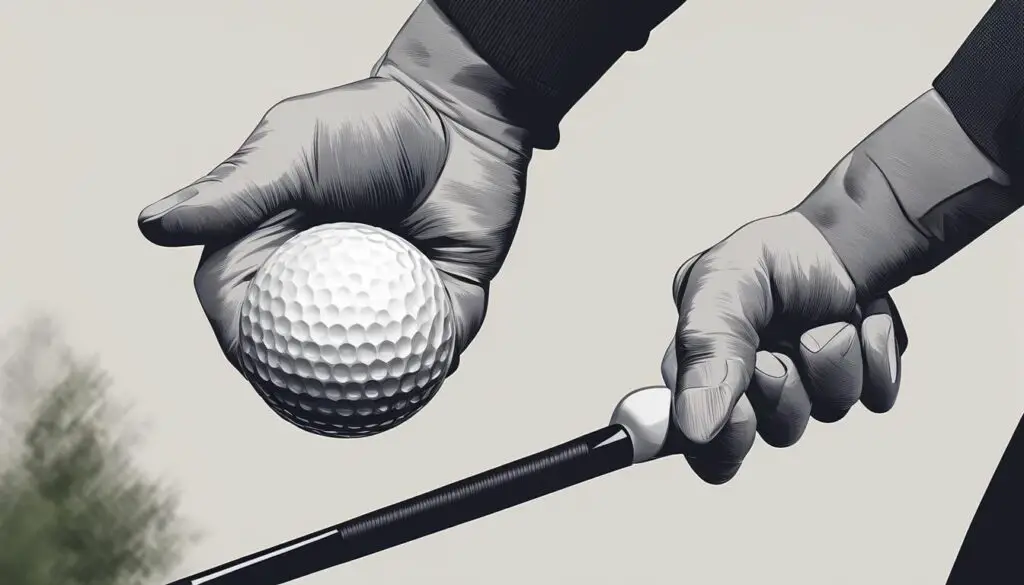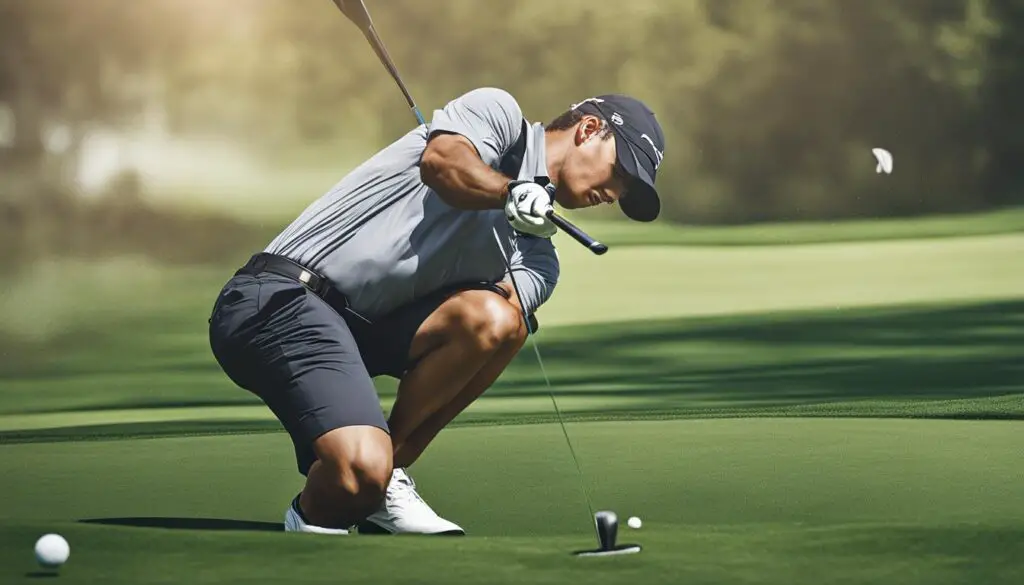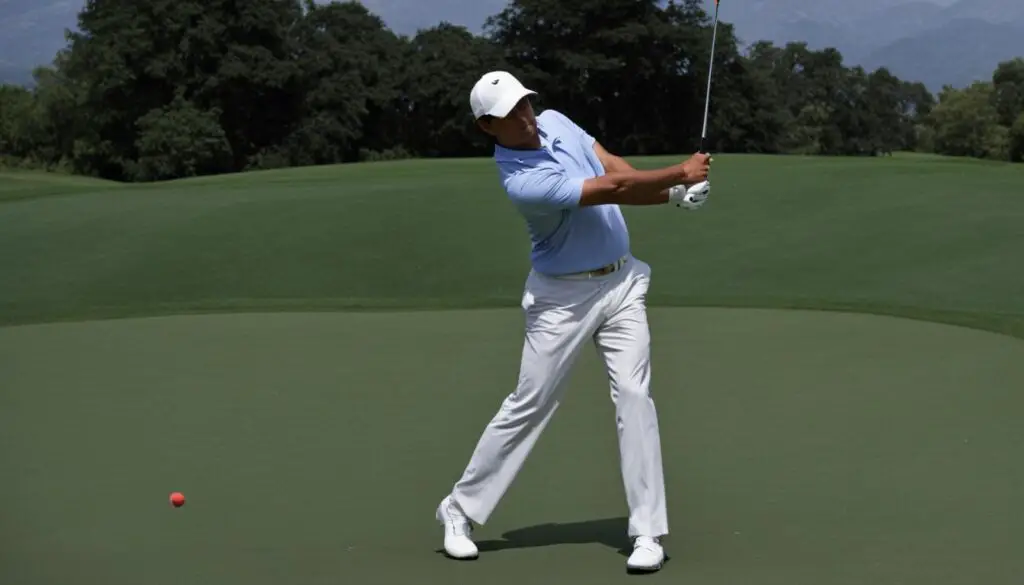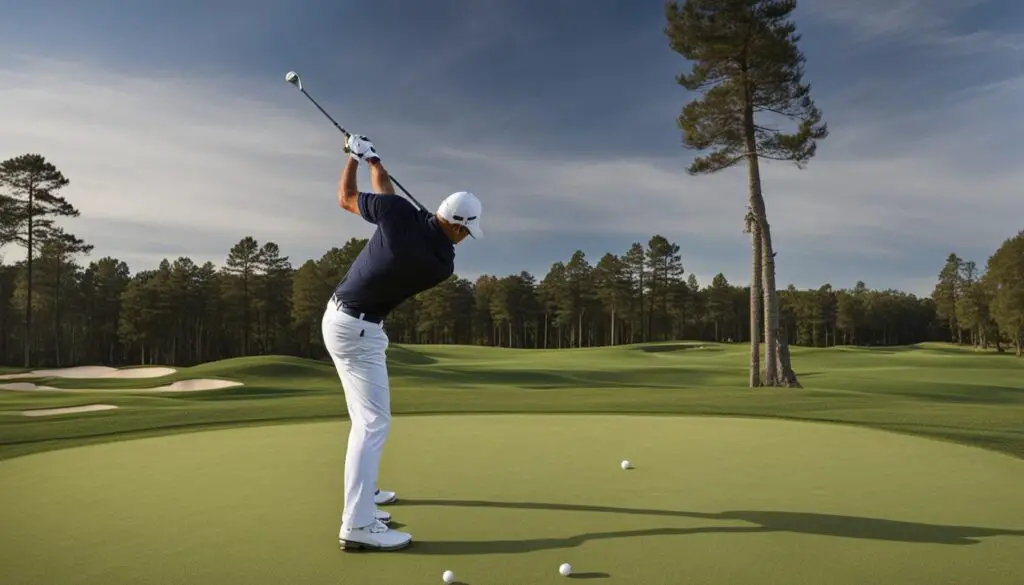Learning how to swing a golf club is essential for beginners looking to improve their game. Whether you’re a novice golfer or someone who wants to brush up on the fundamentals, mastering the basics of a golf swing is key to achieving consistent and accurate shots on the course. In this section, we will walk you through the steps to help you develop a solid foundation for your golf swing, from setting up your stance and grip to executing a smooth follow-through. Let’s dive in and discover how to swing a golf club like a pro!
Key Takeaways:
- Position your feet and align your body correctly for a proper setup.
- Choose a comfortable and effective grip for better control and accuracy.
- Focus on a smooth backswing, utilizing your core muscles.
- Shift your weight and use your body rotation during the downswing for power and control.
- Finish your swing with good form, balance, and a comfortable follow-through.
Set Up Your Stance and Alignment
When it comes to mastering the basics of a golf swing, setting up your stance and alignment correctly is crucial. This forms the foundation for a smooth and effective swing. Here are some key points to keep in mind:
- Positioning: Start by positioning your front foot slightly ahead of the ball, with your feet a little wider than shoulder-width apart. This provides stability and allows for better weight transfer during the swing.
- Club Placement: Place your bigger clubs towards your front foot and smaller clubs towards the middle of your stance. This helps ensure optimal contact with the ball and allows for proper clubhead speed.
- Alignment: Check your alignment to ensure your feet and shoulders are pointed directly at your target. This helps you aim accurately and promotes a straighter shot. Use alignment aids or markers on the ground to assist in achieving the correct alignment.
By setting up your stance and alignment properly, you’ll be able to establish a solid foundation for your golf swing. This will increase your chances of hitting accurate and powerful shots, especially as you continue to develop your swing technique.
“Good golf begins with a good setup. Take the time to position yourself correctly for each shot, and you’ll see a noticeable improvement in your swing.” – Golf Pro
Remember, mastering the basics of a golf swing is a continuous process. Take the time to practice your stance and alignment regularly to develop muscle memory and consistency. This will ultimately contribute to better overall performance on the golf course.
Golf Swing Technique Tips:
- Start with your front foot slightly ahead of the ball.
- Place bigger clubs towards your front foot and smaller clubs towards the middle of your stance.
- Ensure your feet and shoulders are pointed directly at your target.
- Use alignment aids or markers on the ground to assist with alignment.
- Practice your stance and alignment regularly to develop consistency.
Perfect Your Grip
One of the fundamental aspects of a proper golf swing is a correct grip. The way you hold the golf club can greatly impact your swing and overall accuracy. It is essential to choose a grip that feels comfortable to you, as this will allow you to have better control over the club throughout your swing.
There are different types of grips that you can experiment with. The most common ones are the baseball grip, overlap grip, and interlocking grip. Each grip has its own advantages, so it’s important to find the one that suits your hand size and feels natural. Whichever grip you choose, make sure it is relaxed and allows the clubhead to turn over for better accuracy.
“The correct grip can make a significant difference in your swing.”
When positioning your hands on the club, focus on getting your lead hand placement correct. The handle of the club should run from the bottom of your index finger to your heel pad. This will help ensure a solid connection between your hands and the club, allowing for a more consistent swing. Take your time to practice and get comfortable with your grip, as it can greatly impact your overall golf game.
Key Tips for a Perfect Grip:
- Experiment with different grip types (baseball, overlap, interlocking) to find the one that feels most comfortable to you.
- Ensure your grip is relaxed and allows the clubhead to turn over for better accuracy.
- Position your lead hand correctly, running the handle from the bottom of your index finger to your heel pad.
- Practice and get comfortable with your grip to improve your overall golf swing.

Golf Swing Drills: Mastering the Backswing
Mastering the backswing is a crucial step in developing a consistent and powerful golf swing. The backswing sets the foundation for a successful swing, and practicing specific drills can help you improve your technique and overall swing sequence.
One effective drill to enhance your backswing is the “one-piece takeaway” drill. Start by gripping the club with a relaxed grip and keeping your wrists firm. As you initiate the backswing, focus on moving your entire body as a unit, avoiding any excessive wrist movement or hinge. This drill promotes a smooth and connected backswing, allowing for better synchronization of your body and club.
One-Piece Takeaway Drill:
- Start in your setup position, with your feet shoulder-width apart, knees slightly bent, and the club hovering just above the ground.
- Begin the backswing by turning your shoulders and hips together, maintaining a stable lower body.
- As you turn, feel the weight shift from your front foot to your back foot.
- Keep your lead arm straight and avoid any excessive tension in your wrists.
- Continue the backswing until your lead arm is parallel to the ground, with the club pointing toward your target.
- Pause briefly at the top of the backswing before starting the downswing.
Another useful drill for improving your backswing is the “pause and check” drill. This drill helps you develop awareness and control of your positioning at the top of the backswing. After completing your backswing, pause for a moment and check your alignment and club position. Ensure that your lead arm is extended fully, the clubface is square, and your body is properly rotated. This drill helps you maintain consistency and make any necessary adjustments before initiating the downswing.
Practicing these backswing drills regularly can help you develop a solid swing sequence and improve your overall golf game. Remember to focus on maintaining a connected and smooth backswing, avoiding any unnecessary movements or tension. With consistent practice and attention to detail, you’ll see improvements in your swing and enjoy greater success on the golf course.
Follow Through with Your Downswing
The downswing is a critical phase of your golf swing that requires proper mechanics and analysis to achieve optimal results. Mastering the art of the downswing will improve your swing power and consistency. Here are some key points to focus on:
- Drag or slightly pull the head of the club: During the downswing, aim to drag or pull the head of the club, allowing it to lag behind your hands. This lag generates power and helps square the clubface at impact.
- Shift your weight and knee movement: Transfer your weight from the ball of your back foot to the ball of your front foot during the downswing. Let your knees move towards the target, promoting a proper weight shift and ensuring a solid strike.
- Forward leaning shaft: To achieve optimal contact, make sure the shaft of the club is leaning forward towards the target at the moment of impact. This forward lean creates a descending blow on the ball, resulting in a crisp and controlled shot.
Remember, the downswing is a continuation of the energy and motion created during the backswing. Focus on maintaining a smooth and rhythmic transition to achieve a consistent and powerful downswing.
Pro Tip: “Efficient downswing mechanics can significantly improve your swing speed and distance. Practice proper weight transfer and shaft lean to unlock your full potential.”
Image:

Complete Your Swing with a Follow-Through
The follow-through is a crucial component of a successful golf swing. It helps ensure proper form, balance, and power throughout the entire swing motion. By completing your swing with a strong follow-through, you can improve your golf swing technique and increase your chances of hitting accurate and powerful shots.
One key aspect of the follow-through is maintaining a comfortable finish position. As you strike the ball, focus on keeping your belt buckle facing the target. This helps ensure that your body is aligned correctly and promotes a straighter shot. Additionally, allow the club to swing through behind you. This helps maintain a smooth and fluid motion, rather than abruptly stopping the swing at impact.
Remember, the follow-through is not about trying to overpower the swing. Instead, it’s about maintaining good form, rhythm, and balance until the ball is in flight. By focusing on these elements, you can execute a more consistent and effective golf swing.
Throughout your swing, it’s important to keep your eyes on the ball. This helps maintain focus and ensures that you make solid contact. Additionally, avoid any jerky or abrupt movements during the follow-through. Instead, aim for a smooth and controlled finish. This will help you maintain stability and control throughout the entire swing.
Key Points:
- Finish your swing with your belt buckle facing the target and the club swung through behind you.
- Keep your eyes on the ball throughout the swing for better focus and contact.
- Maintain a comfortable and balanced finish position until the ball is in flight.
- Avoid trying to overpower the swing; focus on maintaining good form and rhythm.
Slicing: Correcting Common Swing Errors
If you find yourself frequently slicing the ball, don’t worry, you’re not alone. The slice is one of the most common swing errors in golf, but it can be corrected with a few adjustments to your technique. By understanding the root causes of slicing and implementing the right changes, you can straighten out your shots and improve your overall game.
One of the main reasons for a slice is an open clubface at impact. To combat this, focus on keeping your knees bent throughout your swing. This helps you maintain a solid foundation and promotes a more consistent swing plane. Additionally, pay close attention to your wrist and clubface positioning. Make sure your wrists are not overly cupped or bowed, and ensure the clubface is square at impact.
Another aspect to consider when trying to correct a slice is your swing path. A slice is often caused by an out-to-in swing path, where the club approaches the ball from the outside and cuts across the target line. To fix this, concentrate on swinging down the target line with a square clubface. Practice swinging along an imaginary inside-out path, focusing on bringing the club back to the ball from the inside.
Lastly, maintaining a relaxed grip can greatly assist in reducing slice errors. A grip that is too tight can restrict the natural release of the clubhead and promote an open clubface at impact. Experiment with different grip pressures and find what works best for you. Remember, a slice can be frustrating, but with some adjustments to your swing mechanics and a little practice, you can overcome this common error and start hitting straighter shots on the course.
“The slice is one of the most common swing errors in golf, but it can be corrected with a few adjustments to your technique.”

Key Takeaways:
- Maintain a relaxed grip to promote a natural release of the clubhead.
- Focus on keeping your knees bent throughout your swing for a solid foundation.
- Ensure your wrists and clubface are properly positioned at impact to avoid an open clubface.
- Practice swinging along an inside-out swing path to combat an out-to-in swing path.
- With the right adjustments to your swing mechanics and consistent practice, you can overcome the slice and improve your golf game.
Mastering the Pre-Swing Basics – Grip
One of the key elements of a successful golf swing is a proper grip. The way you hold the golf club can greatly impact your swing technique and overall performance. It is essential to understand how to grip the club correctly for optimal control and consistency in your shots.
To start, place the club in your fingers, not your palm, to ensure a secure and comfortable grip. Create a “V” shape with your thumbs and pointer fingers, pointing towards your trailing shoulder. This grip allows for better clubface control and promotes a natural release of the club through impact.
Additionally, pay attention to the pressure applied with your grip. A grip that is too tight can restrict the freedom of your swing, while a grip that is too loose can lead to loss of control. Find the balance that works for you, maintaining a firm but relaxed grip on the club.
Grip Tips:
- Experiment with different grip styles, such as the overlapping grip or interlocking grip, to find the one that feels most comfortable and natural for you.
- Ensure the handle of the club runs from the bottom of your index finger to your heel pad, providing stability and control.
- Practice your grip regularly to reinforce muscle memory and develop consistency in your swing technique.
“The grip is the foundation of your golf swing. It sets the stage for the entire motion. Take the time to establish a proper grip and you’ll see improvements in your swing and overall game.” – Golf Pro
By mastering the basics of the grip, you’ll have a solid foundation for your golf swing. With practice and proper technique, you’ll be able to achieve greater control and consistency in your shots. Remember, a good grip is key to unlocking your full potential on the golf course.
Mastering the Pre-Swing Basics – Aim
When it comes to a successful golf swing, proper aim is crucial. Instead of aligning your body directly at the target, it’s important to focus on aiming your club face towards the target. This ensures that you have a better chance of hitting the ball accurately and achieving your desired result. To set up your aim correctly, follow these steps:
- Choose a secondary target on the ground that is in line with your desired target.
- Position your feet and shoulders parallel to this target line, rather than directly at the target.
- Maintain a relaxed and balanced stance, with your weight evenly distributed between your feet.
By aligning your body parallel to the target line and aiming your club face towards the target, you increase your chances of hitting the ball straight and minimizing errors. Remember to maintain this alignment throughout your swing to ensure consistent results.

Pro Tip: Visualize Your Shot
Imagine a straight line connecting your ball to the target in the distance. Visualize your shot following this line, with the ball soaring into the air and landing exactly where you want it to. This mental imagery can help you align your body correctly and improve your aim.
By mastering the pre-swing basics of aim, you set yourself up for success in every golf swing. Remember to practice this fundamental aspect of your game to consistently achieve accurate shots and lower scores.
Mastering the Pre-Swing Basics – Stance and Posture
Your stance and posture are crucial elements of your golf swing. A solid foundation and proper alignment can greatly improve your swing mechanics and overall performance on the course. Here are some key tips to help you master the pre-swing basics of stance and posture:
- Stand with feet shoulder-width apart: Begin by positioning your feet slightly wider than your shoulders. This wider stance provides stability and balance throughout your swing.
- Maintain a slight knee bend: Keep your knees flexed throughout your swing. This slight knee bend helps to create a stable base and allows for proper weight transfer during your swing.
- Keep your back fairly straight: Avoid slouching or rounding your back. Instead, maintain a neutral spine position with a slight bend forward from your hips. This posture promotes a more athletic and powerful swing.
- Bend at the waist: Instead of reaching or lifting your arms out towards the club, reach for the golf ball by bending at the waist. This position allows your arms to hang naturally and promotes good posture and balance.
- Ensure your arms hang straight down: Let your arms hang freely with a relaxed posture. Avoid any tension or stiffness in your arms, as this can restrict your range of motion and affect your swing.
By mastering the pre-swing basics of stance and posture, you set yourself up for a more consistent and effective golf swing. Practice these fundamentals and focus on maintaining a balanced and athletic position throughout your swing.
Quote of the Section:
“Good posture is the foundation for a powerful and accurate golf swing.”
Now that you have mastered the basics of stance and posture, it’s time to move on to the next section: Understanding the Backswing. This crucial part of the golf swing sets the foundation for a successful shot. Stay tuned!
Understanding the Backswing
Mastering the backswing is key to achieving a powerful and accurate golf swing. The backswing sets the foundation for your swing, positioning your body and club in the optimal position for the downswing and follow-through.
When it comes to the mechanics of the backswing, it’s important to focus on using your big muscles rather than relying on your wrists. Start by rotating your torso, engaging your core, shoulders, and arms. This rotation creates the necessary coil and generates power.
As you take the club back, keep the motion slow and low to the ground. This helps maintain a smooth tempo and prevents unnecessary tension in your swing. Pay attention to the rotation of the clubhead, ensuring it stays on the correct plane throughout the backswing. Additionally, be mindful of your wrist action, maintaining a controlled and natural movement.
Remember, the backswing is not about hitting the ball. It’s about setting up the perfect position to unleash power and accuracy during the downswing and follow-through.
Practice your backswing mechanics regularly to develop muscle memory and consistency. Focus on maintaining a smooth and controlled motion, utilizing your core, shoulders, and arms. By understanding the importance of the backswing and honing your technique, you’ll be well on your way to improving your golf swing mechanics and analysis.
Mastering the Downswing
Once you have perfected your backswing, it’s time to focus on the crucial downswing phase of your golf swing. This is where the power and control are generated, and it plays a significant role in achieving a solid and accurate shot.
One key aspect of the downswing is using your body’s rotation to transition smoothly from the backswing. As you shift your weight from the ball of your back foot to the ball of your front foot, allow your hips to lead the way and swing energy into your shot. This rotation not only adds power to your swing but also helps you maintain control and accuracy.
Another essential element of the downswing is maintaining the proper clubface positioning. As you initiate the downswing, ensure that your clubface is square to the target. This will help you achieve optimal impact and produce straighter shots. Focus on the feeling of your hands leading the clubhead and keeping the clubface square throughout the entire downswing.
Lastly, use your body’s rotation to guide the swing and achieve a smooth and controlled motion. Let your body rotate naturally, allowing your upper body, hips, and lower body to work together seamlessly. Avoid any abrupt movements or overcompensation, as they can disrupt your swing’s rhythm and result in erratic shots.

Summary:
- Use your body’s rotation to transition from the backswing to the downswing.
- Shift your weight from the ball of your back foot to the ball of your front foot, and let your hips lead the way.
- Maintain the proper clubface positioning during the downswing for optimal impact.
- Focus on the feeling of your hands leading the clubhead and keeping the clubface square.
- Let your body’s rotation guide the swing and maintain a smooth and controlled motion.
Achieving a Proper Finish
Completing your golf swing with a proper finish is crucial for achieving consistent and accurate shots. A proper finish involves maintaining balance, club position, and body alignment. It is the final step in executing a well-rounded swing.
During the follow-through, ensure that your belt buckle is facing the target, indicating proper rotation of your body. This position helps maintain balance and control throughout the swing. Additionally, ensure that the club has swung through behind you, which signifies proper extension and release of the clubhead. Keeping your weight balanced on your lead foot promotes a smooth and controlled finish.

Throughout the swing, it is essential to maintain focus on the ball. Keep your eyes on the ball from the address position through the contact with the ball and into the follow-through. This focus helps maintain proper alignment and positioning during the swing. Remember, the finish is not just about power; it should emphasize form and rhythm.
Troubleshooting Common Swing Issues – Slice Correction
Are you struggling with a slice in your golf swing? Don’t worry, you’re not alone. Many golfers face this common issue that causes the ball to curve from left to right (for right-handed players). To fix this problem, it’s important to analyze your swing mechanics and make the necessary adjustments.
One key area to focus on is your grip. Ensure that your grip pressure is just right – not too tight, as it can restrict your wrist movement, and not too loose, as it can lead to clubface control issues. Find a comfortable balance that allows you to maintain control throughout your swing.
Proper alignment is also crucial. Make sure your clubface is square at impact, which means it should be facing the target. If your clubface is open or closed at impact, it can contribute to a slice. Take the time to align yourself correctly and ensure that your body and club are properly aligned with the target.
In addition to grip and alignment, it’s essential to work on your swing mechanics. Focus on maintaining a balanced swing that promotes a square clubface at impact. Practice maintaining a smooth tempo and utilizing your body’s rotation to guide the swing. With time and practice, you can eliminate slice errors and improve the consistency of your shots.
FAQ
What are the basic steps to swing a golf club for beginners?
Position your front foot slightly ahead of the ball, choose a comfortable grip, rotate your torso for the backswing, shift your weight for the downswing, and finish with a balanced follow-through.
How do I grip the golf club correctly?
Place the club in your fingers, not your palm, creating a “V” shape with your thumbs and pointer fingers. Find a grip that feels comfortable and supports your swing.
How should I align my body for a golf swing?
Instead of aiming your body at the target, aim your club face towards the target and align your body parallel left (for right-handed players). Choose a secondary target on the ground to ensure proper alignment.
What should my stance and posture be like for a golf swing?
Stand with feet shoulder-width apart and a slight knee bend, keeping your back fairly straight. Reach for the golf ball by bending at the waist and ensure your arms hang straight down.
What should I focus on during the backswing?
Use your core, shoulders, and arms to take the club back slowly and low to the ground. Pay attention to rotation of the club head and wrist action for proper positioning.
How can I generate power and control during the downswing?
Shift your weight from the back foot to the front foot, use your hips to swing energy into your shot, and maintain proper clubface positioning. Let your body’s rotation guide the swing.
What is the importance of a proper finish in a golf swing?
Finish your swing with your belt buckle facing the target, the club swung through behind you, and your weight balanced on your lead foot. Maintaining a comfortable finish promotes form and rhythm.
How can I correct a slice in my golf swing?
Pay attention to grip pressure, alignment, and swing mechanics. Ensure your grip is not too tight or too loose, work on a balanced swing, and focus on proper wrist and clubface positioning.
